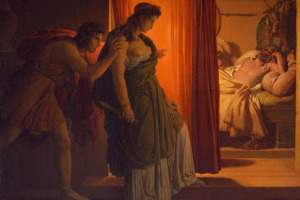Agamemnon in The Odyssey: The Death of the Cursed Hero
 Agamemnon in The Odyssey is a recurring character in the form of several cameos across Homer’s Classic. In its precursor, the Iliad, Agamemnon was known as the King of Mycenae, who waged war on Troy to take his brother Menelaus’s wife, Helen.
Agamemnon in The Odyssey is a recurring character in the form of several cameos across Homer’s Classic. In its precursor, the Iliad, Agamemnon was known as the King of Mycenae, who waged war on Troy to take his brother Menelaus’s wife, Helen.
Who Is Agamemnon in The Odyssey?
After the fall of Troy, King Agamemnon took Cassandra, Priam’s daughter and priestess of Troy, as part of the spoils of war. The two sailed back to the kingdom, where they both met their demise by Agamemnon’s wife, Clytemnestra, and her lover Aegisthus, the son of Thyestes. In the Odyssey, the ghostly spirit of Agamemnon appears before Odysseus in the Kingdom of Hades, who tells the tale of his murder, and warns him of the dangers of trusting women.
The tale of the death of Agamemnon was constantly repeated in the Homeric Classic as a parallel to the similar narrative of Odysseus and Telemachus, Odysseus’ son. To expound further into this connection, we must first be briefed on the unfortunate death of Agamemnon. Let us also explore the abnormal circumstances of the Atreus bloodline, also known as the curse of the House of Atreus.
The Death of Agamemnon
No sooner in the land of Hades did Odysseus encountered Agamemnon, surrounded by his allies who perished alongside him, and greeted each other like old friends. Odysseus inquired whether it was at sea or at land that the former King of Mycenae died. Agamemnon then explained the macabre turn of events after the fall of Troy.
Alongside the priestess Cassandra, he sailed back to the kingdom where Aegisthus, son of Thyestes, invited him to his palace for a feast, honoring his accomplishments in Troy. During the banquet, however, Agamemnon was ambushed and killed by Aegisthus. His men were also slaughtered, while his wife, Clytemnestra, murdered Cassandra over his dying body.
Clytemnestra’s motive for this betrayal stemmed from Agamemnon sacrificing their daughter Iphigenia. Still, it was also jealousy for priestess Cassandra and that Agamemnon had to go to war over his brother’s wife.
It was through this tale that Agamemnon took this chance to warn Odysseus when trusting women. Still, it is also here where he encouraged Odysseus to return to his wife Penelope and ask for the whereabouts of Orestes, the son of Agamemnon. They were not aware of Orestes’s fate, although it was mentioned at the beginning of the Odyssey of his destiny. This twist served as the climax of both of these men’s and their sons’ tales.
The Curse of the House of Atreus
 The family origins of the house of Atreus were riddled with strife and misfortune, coupled with curses from several individuals throughout many generations in the family. This so-called curse began with Tantalus, Agamemnon’s great-grandfather. He used his favor with Zeus to test the gods’ omniscience by trying to feed them his son, Pelops while attempting to steal ambrosia and nectar.
The family origins of the house of Atreus were riddled with strife and misfortune, coupled with curses from several individuals throughout many generations in the family. This so-called curse began with Tantalus, Agamemnon’s great-grandfather. He used his favor with Zeus to test the gods’ omniscience by trying to feed them his son, Pelops while attempting to steal ambrosia and nectar.
He was eventually caught and then banished to the Underworld, where he was severely punished. Tantalus was made to stand before a pond that evaporates every time he tries to drink from it, while a fruit tree positioned above him moves away every time he reaches for its fruit. Thus began the series of unfortunate events that occurred in the house of Atreus.
Tantalus’s son, and now Agamemnon’s grandfather, Pelops, persuaded Poseidon to grant him a chariot to participate in a race to beat Oenomaus, the king of Pisa, as well as to win the hand of Hippodamia, his daughter. His friend who helped Pelops win the chariot race, Myrtilus, attempted to lay with Hippodamia and was caught by the angry Pelops. Pelops threw Myrtillus off a cliff, but not before his friend cursed him and his entire bloodline.
Pelops and Hippodamia had many children, including Agamemnon’s father, Atreus, and his uncle Thyestes. Pelops banished Atreus and Thyestes to Mycenae after the two murdered their half-brother Chrysippus. Atreus was named King of Mycenae, however Thyestes and Atreus’s wife, Aerope, later conspired to usurp Atreus, but their actions were futile. Atreus then had Thyetes’s son killed and fed to his father, whereas Atreus taunted him with the severed limbs of his now-dead son.
Now Atreus and Aerope bore three children: Agamemnon, Menelaus, and Anaxibia. The curse of the house of Atreus continues to spread even amongst their lives. Agamemnon was forced to sacrifice Iphigenia, his daughter, to appease the gods in allowing his army to sail for Troy.
In Sophocles’s Ajax, the armor of the fallen warrior Achilles was given to Odysseus by Agamemnon and Menelaus, Odysseus’ friend. Blinded by rage and jealousy, Ajax was driven mad and had slaughtered men and cattle, only to resort to suicide shamefully. Ajax cursed the children of Atreus, its family line, and the entire Achaean army at his death. Menelaus’s marriage with Helen has strained after the Trojan War, bearing them no heirs.
Upon his return from Troy, Agamemnon was murdered by Aegisthus, who had become Clytemnestra’s lover while away from the kingdom during the war. Being the son of Thyestes and his daughter Pelopia, Aegisthus exacted revenge for his father by killing his brother and his son. He and Clytemnestra then ruled the kingdom for a period of time before Orestes, the son of Agamemnon, avenged his father and slain both his mother and Aegisthus.
Agamemnon’s Role in the Odyssey
Agamemnon was considered a mighty ruler and a capable commander of the Achaean armies, but even he could not defy the fate that awaited him. The curse that flows in his veins was proof of that, and it was only through this cycle of greed and trickery that has brought misfortune upon himself and those close to him.
However, there is a light at the end of the tunnel for him and his descendants. In the aftermath of Agamemnon’s death, Orestes avenged him through the ends of Aegisthus and Clytemnestra at the insistence of his sister Electra and Apollo. He then wandered over the Greek countryside for many years while being continuously haunted by the Furies. He was finally absolved of his crimes with the help of Athena, which then dispersed the poisonous miasma in their bloodline and thus ended the curse of the house of Atreus.
This tale serves as a recurring parallel between Agamemnon and Odysseus and their respective sons, Orestes and Telemachus. In its precursor, the Iliad narrated the story of King Agamemnon and the atrocities committed in his lifetime, and Odysseus being revered for his wisdom and cunning in the war. And now it was in its sequel, the Odyssey, that the tale of the two fathers was told in parallel to the stories of the two sons.
The beginning chapters of the Odyssey narrates the tale of young Telemachus, determined to search for his father after the Trojan War while exhibiting the positive qualities of what should be a good ruler in the absence of his father. Both sons were, in some way, able to succeed their fathers and earned the favor of the revered goddess Athena.
On the other hand, Orestes was infamously known at the beginning of the Odyssey as a murderer of not just anyone but his mother. He was acquitted in what was known to be one of the first court cases, and with the help of Athena, was able to erase the curse from his family’s bloodline.
Conclusion
Now that Agamemnon’s bloody history and death have been established, let us go over the critical points of this article.
 Agamemnon was the former King of Mycenae, who waged war on Troy to take his brother Menelaus’ wife, Helen.
Agamemnon was the former King of Mycenae, who waged war on Troy to take his brother Menelaus’ wife, Helen.- Odysseus and Agamemnon were friends who met and fought in the Trojan war.
- Agamemnon in the Odyssey is a recurring character in the form of several cameos across Homer’s Classic.
- After winning the war, he returned to his kingdom, only to be murdered by his wife and Aegisthus.
- The unfortunate event only occurred because of the curse of the house of Atreus.
- He encountered Odysseus in the Underworld and used this chance to narrate his tale to warn him about trusting women.
In contrast to Odysseus and Telemachus’ tales of heroism and adventure, Agamemnon and Orestes were that of a never-ending cycle of spilled blood and revenge. It was not so much as Agamemnon himself appearing in the classic, instead of the aftermath of his death and the fate of all his descendants being tested.
Orestes was the direct offspring of that mighty warlord. While he did start the cycle again by killing his mother to avenge his fallen father, he had broken that cycle immediately by showing remorse for his actions. He turned to atonement by wandering the countryside, chased by the furies. Athena had taken him to court, where he was then cleared of his sins and the curse and has finally brought neither revenge nor hatred but justice to his family.

